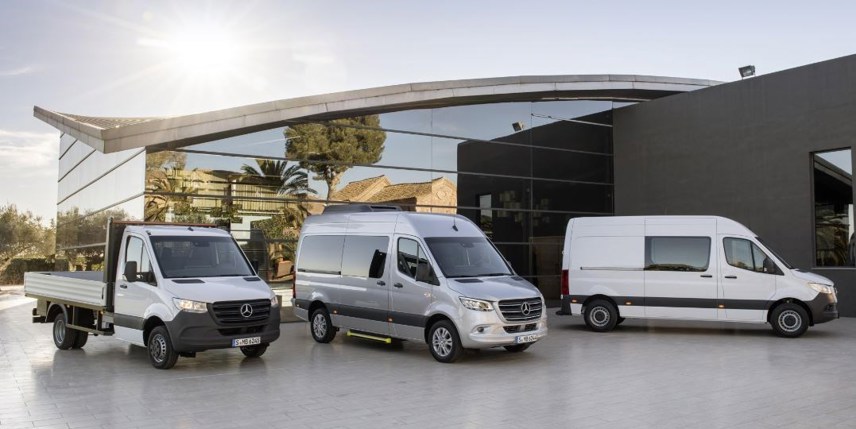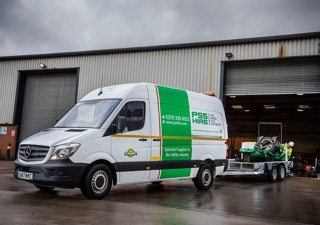Review
John Lewis discovers that the Mercedes-Benz "first" front wheel drive Sprinter increases payload and fleet appeal in the first drive review.
Restyled both internally and externally, Mercedes-Benz’s latest, third-generation Sprinter comes with a host of changes which should help widen its appeal to fleets.
Among them is the arrival of front-wheel drive for the first time; previous Sprinters were rear-wheel or four-wheel drive only.
Choosing front-wheel drive wins you a 50kg payload capacity boost, 0.5cu m more cargo space and a loading height that is 80mm lower than that of rear-wheel-drive models. They remain available alongside the 4x4 derivatives.
Where home delivery is concerned payload really counts, says Stuart Skingsley, head of fleet at Ocado, who was present at Sprinter’s press launch at Duisburg in Germany.
“We can use every extra kilo,” he said. “The more food we can get on each vehicle, the fewer vehicles we need.”
Front-wheel drive Sprinters gross at 3.0 to 4.1 tonnes while their rear-wheel drive counterparts gross at 3.0 to 5.5 tonnes.
Another key development is the introduction of an optional nine-speed automatic gearbox – a first for the large van sector – on front-wheel drive variants alongside a new six-speed manual gearbox.
While diesel continues to dominate the Sprinter portfolio, an electric version is joining the line-up. Following on from the eVito, and likely to gross at 4.25 tonnes, the eSprinter will debut in 2019.
“We’re electrifying our entire commercial vehicle portfolio step-by-step,” said Daimler chairman Dieter Zetsche.
As important as changes to the vehicle itself so far as Mercedes-Benz is concerned is the advent of a host of web-based support packages designed to link fleet managers and drivers and make life easier for both; and for the fleet’s customers.
Eight will be available ex-factory under the Pro banner encompassing everything from maintenance management to monitoring the vehicle’s whereabouts, not to mention the provision of a digital driver’s logbook.
Dynamic route guidance is also on offer. This allows managers to respond if conditions change during the course of a working day to affect planned delivery schedules.
“If the job schedule changes at short notice then an algorithm recalculates the routes to fit,” said worldwide head of Mercedes-Benz Vans, Volker Mornhinweg.
It is worth noting that Mercedes has become the first vehicle manufacturer to use the ‘what3words’ address system, which assigns three words to any point on the earth’s surface to make navigation more precise.
The packages can be used in conjunction with the new MBUX multi-media system, on offer with a seven-inch or 10.25-inch dashboard display with touchscreen and voice control.
“Sprinter is the second vehicle in the entire group to receive MBUX,” said Zetsche.
A high-speed internet connection integrated into the vehicle can either be used in conjunction with PRO or as a hotspot to connect separate mobile devices. Smartphones can be charged wirelessly.
Using the Advance slogan, Mercedes-Benz is planning to integrate Sprinter into the customer’s supply chain through a variety of web-driven services in areas such as van rental and sharing.
“We want to create mobility packages which meet the challenges of tomorrow and the day after in both goods and passenger transport,” said Mornhinweg.
“So far as we’re concerned the new Sprinter is to conventional vans what the smartphone is to a plain old mobile phone.”
At the time of writing it was unclear to what extent these services would be offered in the UK. Safety is not being neglected.
Driver assistance systems include a reversing camera which projects its image onto the rear view mirror in the cab and a parking package which gives drivers a 360-degree bird’s-eye view of what’s happening around the vehicle.
Available, too, is a wiper system with a rain sensor. Fluid from the washer bottle goes through the wiper arms, is sprayed directly ahead of the wiper blades, then immediately wiped away.
Mercedes clearly has confidence in the reliability and durability of its new offering, with service intervals of up to 37,500 miles/two years envisaged for rear-wheel drive models.
Not such a known quantity, for the moment front-wheel drive Sprinters will need servicing at up to 25,000 miles/two years.
Now with key-less start and sold as a chassis cab as well as in van guise, Sprinter retains the 190PS 3.0-litre diesel familiar from the previous model.
Carried over also are the outgoing Sprinter’s 2.1-litre diesels at 115PS, 145PS or 165PS.
The last-named option is not available in front-wheel drive variants.
Maximum van load is 17cu m while maximum payload capacity is 3,150kg if you opt for the 5.5-tonner.
“We should see the first new Sprinters delivered and on the road by April/May time,” said Mercedes-Benz Vans UK managing director Steve Bridge.
“We’ll have the rear-wheel-drive vans and chassis cabs and front-wheel drive vans available first with the front-wheel drive chassis a bit later and the entire range by the third quarter of the year aside from eSprinter.
“We should have that early next year,” he added.



















